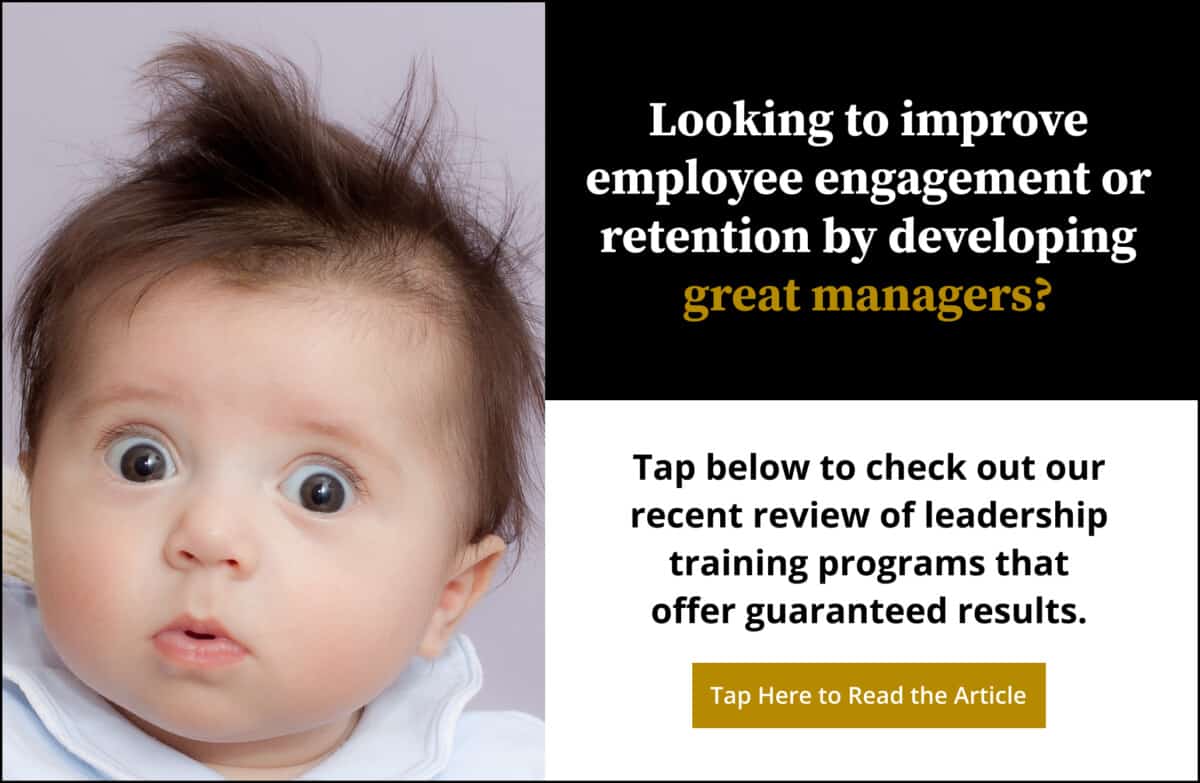Share:

Voluntary turnover is costing U.S. businesses a trillion dollars a year.
The expense of replacing an employee can range from one-half to two times the employee’s yearly salary. Based on data from the Bureau of Labor Statistics, the annual overall turnover rate in the U.S. in 2017 was 26.3%.
That means a 100-person organization that pays an average salary of $50,000 could have turnover and replacement costs of $660,000 to $2.6 million annually.
Fast forward a few years, and the picture gets more grim. The national average annual turnover rate as of 2021 was 57.3%, with the number of workers who left their jobs due to quitting, layoffs, or any other separation increasing to 6.2 million people in September of that year.
We all know the important role retention plays in an organization’s profitability. Unfortunately, increasing employee retention continues to be a challenge for many organizations, with 47% of human resource professionals citing retention/turnover as the top workforce management challenge.
It is a challenge companies that want to survive and remain profitable must address because it is so much more cost effective to retain qualified and highly skilled employees than to train and onboard new hires. But retention has many other financial benefits for businesses.
A benefit of retention for organizations is the impact it has on an organization’s overall profitability. A high retention rate can reduce the costs associated with turnover and improve employee engagement, employee morale, performance, productivity, customer service, and organizational culture.
In this article, we’ll explore the various ways retention benefits organizations and makes them more profitable.


The Cost of Low Retention
In addition to the costs of replacing an employee, there are many ways high turnover can spell disaster for companies.
When experienced employees leave, it can cause a significant loss of institutional knowledge that is hard to recuperate. This can hurt customer satisfaction and customer retention. It can also make it more challenging to onboard and train new employees.
It is inevitable that every organization will experience some amount of employee turnover, no matter how great the organization’s culture is or how competitive the compensation is. This is a completely normal part of business but can become a crisis when there is a high rate of turnover.
Unfortunately, the costs of high turnover aren’t just monetary.
High rates of turnover can hurt employee morale, engagement, and well-being. These things can have a negative effect on profits, but the extent to which they impact the employee experience and an organization’s culture is immeasurable.
High turnover can create a very unpleasant work environment that breeds more turnover, creating a retention crisis that impacts the organization at every level. It can also create a toxic work environment where burnout is high and job satisfaction is low.
Additionally, the time and effort managers have to spend on dealing with attrition leaves them less time to spend with current employees. When turnover is high, managers have to focus much of their daily efforts on retention and getting the right employees to fill the vacated roles.
This can leave employees feeling ignored and unappreciated. As a result, morale can take a nosedive, paving the way for disengagement.
When retention is high, managers are able to spend more of their time tending to their teams, which is good for morale, engagement, performance, and, ultimately, retention.
Retention Is Good for Profitability
Because the costs associated with recruitment can be so high, it can negatively impact an organization’s long-term profitability.
Though it can vary by role and by industry, the average cost of hiring an employee is estimated to be around $4,000. Recruiting, training, and competitive benefits packages add additional costs. Organizations spent more than $92 billion in 2020-2021 on training alone.
In addition to the expense of replacing an employee that leaves, the employee shortages associated with high turnover can cause employees who stay to experience burnout and more stress due to working longer hours and taking on more job duties.
Whenever an organization loses a talented employee, they lose institutional knowledge, which is extremely important for the success of the organization because it provides much needed consistency and continuity (which helps other employees) and is extremely difficult to replace.
In addition to the loss of institutional knowledge that occurs when a long-tenured employee leaves, an organization also loses “cultural DNA” when these employees leave, and there is also an “opportunity cost,” which is the potential value the employee could have brought to the organization.
An organization’s revenue can be significantly increased when it reduces the expense associated with hiring. The organization can also benefit financially from the improvements in employee engagement, morale, performance, productivity, customer service, and organizational culture that high retention offers.
Retention Is Good for Employee Engagement
According to Gallup, only 32% of full- and part-time employees in the U.S. are currently engaged, while 17% are actively disengaged, an increase of one percentage point from last year. Engagement doesn’t just boost retention, it can be boosted by retaining engaged employees.
Retention isn’t just about keeping employees, it’s about keeping engaged employees. Fostering a work environment that is conducive to employee satisfaction is good for retention, but it’s also great for improving engagement.
Employees who stay with an organization tend to be engaged in the work they are doing. They are more productive and better at retaining customers. Engaged employees will feel a sense of purpose in their work, which will motivate them to do their work well.
When you create the ideal conditions for an employee to stay, you are positively shaping their employee experience and providing the ideal conditions for them to engage with their work.
Retention Is Good for Employee Morale
High turnover can have a negative impact on employee morale, leading to a toxic work environment, which can lead to more turnover. Maintaining high retention is one of the best ways to combat low morale.
Employees can become overworked due to the increased workloads and responsibilities that come with turnover, and this can continue until those open positions are filled. Newly hired employees will feel the impact of low morale as they struggle to quickly learn their new job duties.
Quitting can also be contagious, as we’ve seen with The Great Resignation. Employees may decide to look for greener pastures themselves when they see so many of their co-workers leaving.
Low morale can create a vicious cycle of poor performance, high absenteeism, low engagement, and even more turnover. The good news is that retaining highly engaged employees can help to keep overall employee morale up, improving the employee experience for all team members.
Retention Is Good for Performance
Because employee retention is strongly correlated with employee engagement, maintaining a high level of retention means you are more likely to retain highly engaged employees. Retaining highly engaged employees is essential to building high-performance teams.
In fact, one of the greatest benefits of high retention and high engagement is the way both can contribute to a culture where high performance is the norm. Engaged employees will care about their jobs and will be more invested in the success of the organization, which motivates them to perform at their best.
Engaged employees are able to connect the dots between their individual performance and the success of the company, making them more aware of how their performance directly impacts the performance of the organization as a whole.
When you retain these workers, you are ensuring that you are building teams that are committed to the mission and values of your business and dedicated to performing well to achieve success.
Another way retention is good for performance is that the longer an employee is with an organization, the more knowledge and expertise they gain and the more they improve their skill set. These experienced employees are often your best performers.
When turnover is high, performance will suffer. High rates of turnover can lead to high rates of absenteeism, burnout, stress, and more turnover, impacting the quality of work being produced.


Retention Is Good for Productivity
High rates of turnover can hurt productivity in several ways.
Staff shortages can impact the overall productivity of an organization and can further impact productivity by causing more burnout, increased absenteeism, and poor employee morale.
It can take a new employee one to two years to reach the level of productivity of an existing employee. It can take even longer for them to achieve their level of institutional knowledge. In a job where customer service is a component of the role, it can also take quite a while for a new hire to build customer rapport.
Organizations with high retention rates typically have employees who are more engaged, and these employees tend to be more productive.
Retention Is Good for Customer Service
Retaining talented employees positively affects customer service. More experienced employees usually provide a better customer experience. This leads to greater customer satisfaction, which can help an organization retain customers.
It takes a while for new hires to build rapport with customers. They may stumble when answering questions and be less skilled at problem-solving as they learn their roles, which can impact customer satisfaction.
After such an experience, a customer could post negative reviews, which can hurt the organization’s reputation. Customers will also notice if you have high turnover rates. It can be an indication to them that they will not receive consistent quality service.
Employees who are loyal to the organization will go above and beyond to protect the business’s reputation, which means always going above and beyond for customers. And customers will take note.
Strong relationships between experienced employees and customers will keep customers coming back. When customers have positive experiences with your staff, it builds brand loyalty and helps you retain those customers.
Retention Is Good for Organizational Culture
Company culture has come to play an increasingly important role in retention. According to a recent study, 34% of workers say culture is the main reason they would consider leaving their current role.
With so many workers now leaving their jobs for reasons other than compensation, being intentional about your company’s culture can help you improve the employee experience.
Employees help shape an organization’s culture, and they help to reinforce it. Having a team of employees with long-term cultural buy-in can help you stay intentional about culture.
According to Business Leadership Today contributors Mark S. Babbitt and S. Chris Edmonds, the loss of talented, engaged people hurts even more when companies are not intentionally culture and values-driven.
“When highly-regarded leaders, mentors, and key contributors leave a company that hasn’t deliberately invested in their culture, the odds are good that culture, and especially that team’s subculture, will become even more accidental/incidental. Perhaps even toxic.”
The loss of trusted managers and other leaders can have a particularly strong impact on an employee’s loyalty to the organization because they play such an important role in building cultural buy-in, especially in organizations that are less intentional about culture. It can have long-term effects on succession planning and consistency within the organization.
Retention Is Good for the Team
When you have high employee retention, it doesn’t just benefit the organization—it benefits the employees who work there.
By boosting engagement, high retention helps employees connect more with and enjoy their work. It creates a more positive work environment where morale is high. It helps employees build rapport and establish harmonious, mutually beneficial relationships with their co-workers, which can improve their mental health.
It also helps employees grow and thrive in their roles when managers are able to spend more of their time leading than recruiting.
Since turnover can be so costly, strong retention strategies are crucial to recruiting and engaging the best talent. These strategies should focus on addressing the factors that are truly driving retention and building a strong organizational culture where leaders are committed to helping employees succeed.

Matt Tenney has been working to help organizations develop leaders who improve employee engagement and performance since 2012. He is the author of three leadership books, including the groundbreaking, highly acclaimed book Inspire Greatness: How to Motivate Employees with a Simple, Repeatable, Scalable Process.
Matt’s ideas have been featured in major media outlets and his clients include numerous national associations and Fortune 500 companies.
He is often invited to deliver keynote speeches at conferences and leadership meetings, and is known for delivering valuable, actionable insights in a way that is memorable and deeply inspiring.


